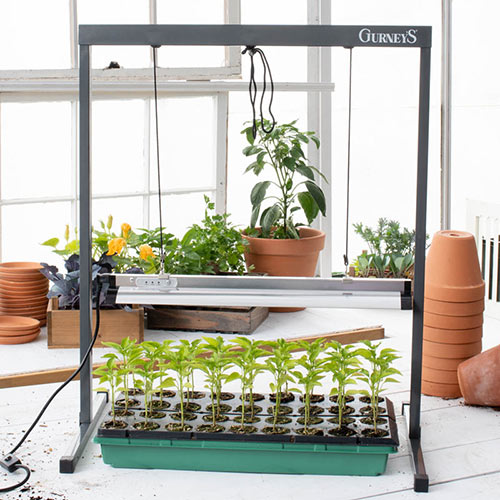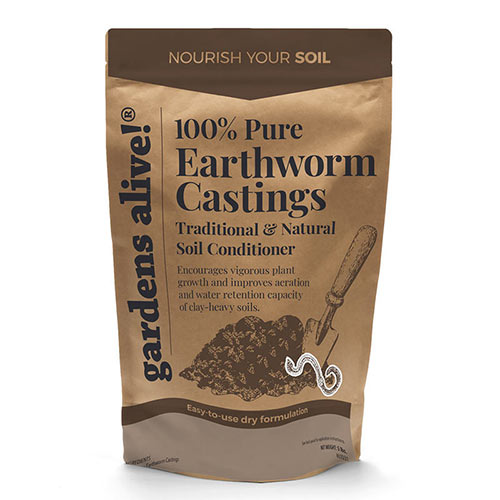Yes—You Can Start Pepper Plants in August!
-
Helpful Products from Gardens Alive!
-
 Grow Light
Grow Light -
 100% Pure Earthworm Castings - Natural Soil Conditioner
100% Pure Earthworm Castings - Natural Soil Conditioner
Q. John from South Philly writes: "Is it too late to plant peppers from seed? I have a special variety that looks like a hot pepper but is sweet. I love them, but I got bad seed this spring. Now I got good seed. Is it too late to get them in?"
A. No John, it is not; and I probably would not say that about any other plant, but peppers are special--both to me personally (they are tied with garlic as my favorite crop) and in their ability to survive many seasons.
Now, if you were in a hot hot zone, like portions of Southern California, Southern Texas or below the frost zone in Florida, it would be the perfect time to start "summer crops" from seed, as summers in these regions are just too torrid for plants that love summer in the Mid-Atlantic and North. Heck, if you live somewhere like Las Vegas or Phoenix, it might still be too early to start plants from seed as humans have not yet emerged from their underground hideaways yet.
And in PA it is much too late to start tomatoes, eggplant, squash and such.
So what makes John so special (besides the fact that he lives in South Philly, where he can walk to the old original Nick's Roast Beef at 20th and Jackson and get the world's most amazing sandwich)? Unlike tomatoes, squash, melons, etc., peppers are perennial; they will live for many years if protected from frost. I remember being in Santa Fe and seeing habanero plants the size of small trees that were decades old. But you don't have to live in Santa Fe to perennialize your peppers; you just have to cheat a little. And remember kids: "cheaters always win".
Start your seeds in the containers they will remain in. Twelve-inch pots are ideal as you can place four of them under a shop light fitted with two four-foot long fluorescent tubes. But because you're starting your peppers at the end of summer/beginning of fall, you don't have to mess with the lights right away--as you would in spring, when growing from seed indoors can be treacherous. Especially when you try it without artificial light, which is when many gardeners learn that "a sunny windowsill" means "death to your tomatoes".
And you're going to grow these puppies over the winter, when "sunny windowsill" means weak light for several hours a day and freezing cold death at night. Always remember that avoiding death is the number one goal in gardening. And in life.
Anywho, make sure your containers have good drainage. Fill them with a {quote} "soil free mix". This may be called seed-starting mix, professional mix, or potting soil. It is the "medium" (that's what we call this stuff) that pros use to start to start the plants you buy in the Spring. It typically contains milled peat moss (plus a little lime or wood ash to counteract the acidity of the peat) or coir (a peat substitute made from coconuts), perlite and/or vermiculite and some compost.
It should NOT contain chemical fertilizers (no matter how 'miraculous' they are claimed or be) or bogus 'water-holding crystals. Natural nutrients like worm castings and such are fine--in fact, they are a sign of quality potting soil.
Fill each pot most of the way with your medium and then saturate it with water by placing the containers in a sink with a couple of inches of H2O for awhile. Then place four seeds in each container, cover the seeds with half an inch of potting soil, take them out of the water and let the containers drain. Keep the pots in a warm spot or place them outside; germination should be speedy either way. Once the first sprouts are up, make sure the baby plants go outside into full sun. Or if you think that rats, mice, groundhogs, weasels, deer, wombats or such will eat the tender young sprouts, go directly to indoors under lights.
If you do leave them outside for awhile, be a coward (cowards also always win) and bring them in for the winter the first time it dips below 50 F at night. Place your containers under the lights with the tops of the plants no more than an inch away from the tubes; make sure you can either raise the lights or lower the plants as we proceed. At four weeks of age, feed everyone with a dilute liquid organic fertilizer. If you use granular fertilizer, be sure to cover it with a little bit of compost or potting soil. Do NOT use chemical fertilizer. If you do, I will find out and make you sorry.
Feed lightly every four weeks or so until we get to Thanksgiving and then use a small pair of scissors to limit the number of successful sprouts to (ideally) one and (maximum) two per pot. If you have four great looking plants in every pot and you oppose capital punishment, go out and get another set of lights and pots.
Feed (gently) once a month and keep the plants tight to the lights. If you do this halfway right, you will have big flowering (maybe fruiting) plants ready to go outdoors in the Spring when the long-range forecast shows nights reliably in the fifties. You'll be harvesting fully ripe peppers by the Fourth of July!
A. No John, it is not; and I probably would not say that about any other plant, but peppers are special--both to me personally (they are tied with garlic as my favorite crop) and in their ability to survive many seasons.
Now, if you were in a hot hot zone, like portions of Southern California, Southern Texas or below the frost zone in Florida, it would be the perfect time to start "summer crops" from seed, as summers in these regions are just too torrid for plants that love summer in the Mid-Atlantic and North. Heck, if you live somewhere like Las Vegas or Phoenix, it might still be too early to start plants from seed as humans have not yet emerged from their underground hideaways yet.
And in PA it is much too late to start tomatoes, eggplant, squash and such.
So what makes John so special (besides the fact that he lives in South Philly, where he can walk to the old original Nick's Roast Beef at 20th and Jackson and get the world's most amazing sandwich)? Unlike tomatoes, squash, melons, etc., peppers are perennial; they will live for many years if protected from frost. I remember being in Santa Fe and seeing habanero plants the size of small trees that were decades old. But you don't have to live in Santa Fe to perennialize your peppers; you just have to cheat a little. And remember kids: "cheaters always win".
Start your seeds in the containers they will remain in. Twelve-inch pots are ideal as you can place four of them under a shop light fitted with two four-foot long fluorescent tubes. But because you're starting your peppers at the end of summer/beginning of fall, you don't have to mess with the lights right away--as you would in spring, when growing from seed indoors can be treacherous. Especially when you try it without artificial light, which is when many gardeners learn that "a sunny windowsill" means "death to your tomatoes".
And you're going to grow these puppies over the winter, when "sunny windowsill" means weak light for several hours a day and freezing cold death at night. Always remember that avoiding death is the number one goal in gardening. And in life.
Anywho, make sure your containers have good drainage. Fill them with a {quote} "soil free mix". This may be called seed-starting mix, professional mix, or potting soil. It is the "medium" (that's what we call this stuff) that pros use to start to start the plants you buy in the Spring. It typically contains milled peat moss (plus a little lime or wood ash to counteract the acidity of the peat) or coir (a peat substitute made from coconuts), perlite and/or vermiculite and some compost.
It should NOT contain chemical fertilizers (no matter how 'miraculous' they are claimed or be) or bogus 'water-holding crystals. Natural nutrients like worm castings and such are fine--in fact, they are a sign of quality potting soil.
Fill each pot most of the way with your medium and then saturate it with water by placing the containers in a sink with a couple of inches of H2O for awhile. Then place four seeds in each container, cover the seeds with half an inch of potting soil, take them out of the water and let the containers drain. Keep the pots in a warm spot or place them outside; germination should be speedy either way. Once the first sprouts are up, make sure the baby plants go outside into full sun. Or if you think that rats, mice, groundhogs, weasels, deer, wombats or such will eat the tender young sprouts, go directly to indoors under lights.
If you do leave them outside for awhile, be a coward (cowards also always win) and bring them in for the winter the first time it dips below 50 F at night. Place your containers under the lights with the tops of the plants no more than an inch away from the tubes; make sure you can either raise the lights or lower the plants as we proceed. At four weeks of age, feed everyone with a dilute liquid organic fertilizer. If you use granular fertilizer, be sure to cover it with a little bit of compost or potting soil. Do NOT use chemical fertilizer. If you do, I will find out and make you sorry.
Feed lightly every four weeks or so until we get to Thanksgiving and then use a small pair of scissors to limit the number of successful sprouts to (ideally) one and (maximum) two per pot. If you have four great looking plants in every pot and you oppose capital punishment, go out and get another set of lights and pots.
Feed (gently) once a month and keep the plants tight to the lights. If you do this halfway right, you will have big flowering (maybe fruiting) plants ready to go outdoors in the Spring when the long-range forecast shows nights reliably in the fifties. You'll be harvesting fully ripe peppers by the Fourth of July!
-
Helpful Products from Gardens Alive!
-
 Grow Light
Grow Light -
 100% Pure Earthworm Castings - Natural Soil Conditioner
100% Pure Earthworm Castings - Natural Soil Conditioner







 Gardens Alive! & Supplies
Gardens Alive! & Supplies




